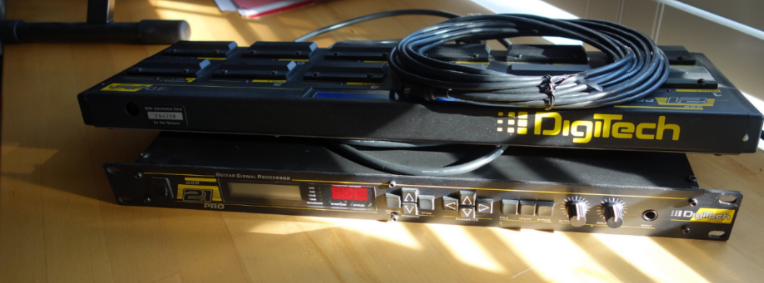I’m not a hoarder – at least, I try not to be – but there are some items of equipment I’m not using and probably don’t need to keep. They are either in storage, or mounted in a rack, taking up space but providing passive heat sinking.

One of these items is my venerable Digitech GSP21-Pro. This is a very capable guitar effect processor and I think it could go to someone who would actually use it rather than just leave it sitting around. I brought this over from New Zealand, so it required a 240V mains supply. About 50% of my gear has been running on a grunty 120-240 mains transformer, so I’ve never bothered to take a close look at the power supply on this unit. However, if I am to pass this on to someone else, it will really need to run on a 120V supply.
Given my recent success with my Korg EX-8000 , I figured I’d open it up and see what was needed to convert the power supply. It turns out that it couldn’t be simpler:

The easily switched voltage plus the standard appliance socket means that it was trivial to switch it over to 120V. Embarrassing! I could have done this years ago and not needed to run it on the big transformer.
However, I did have a problem: The GSP21 had forgotten all of the custom programs I’d set up over the years, and when turned on, goes to patch 01 instead of the last used setting. Typically this behavior is due to the internal memory backup battery being dead. If I was to sell or gift the unit to someone else, I wanted to be confident that their own patches would be retained in memory while the unit was switched off.
The internals are easily accessed by removing a series of screws from the chassis. The backup battery is identified quickly, tucked away neatly at one side of the PCB. I expected a coin-style CR-2032 but it’s quite different:

That battery lasted at least 20 years before giving up. Impressive.
After some research I found that it is actually very difficult to find a No.523 battery of this type. One possible replacement is A21/A133 4.5 Volt Alkaline Battery which can be found at BatteryMart.com under the item code BAT-A21PX.

It is almost a perfect drop-in replacement except for a 1mm gap. I tried bending the battery socket arms inward to eliminate the gap but it wasn’t really possible without potentially stressing the PCB. It’s not really designed to be bent – it’s quite strong spring-steel.
My solution was to use a paper clip. Really low-tech but seems to work well:

It closed the circuit and the battery is firmly held in place. Turning on the unit for the first time showed “restoring factory patches….” for a second, before making patch 01 available. The second time I powered it up, the patches were available immediately, and it remembered which patch I had selected prior to turning the unit off. Success!
I cleaned the exterior of the unit, and offered it on NextDoor.com along with cables, the footpedal unit, and a ragged photocopy of the user manual (which is all I had). And now it is in someone else’s hands, hopefully to give many more years of effective use. I highly recommend the UltraVerb reverb algorithm; it’s very good.
A Refurb’d Reverb.
0 Comments
1 Pingback